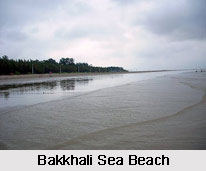 Bakkhali Beach is one such place that is located in South 24 Parganas district of West Bengal. Bakkhali Beach is a seaside that has a lot to offer, being located on the many deltaic islands spread across southern Bengal.
Bakkhali Beach is one such place that is located in South 24 Parganas district of West Bengal. Bakkhali Beach is a seaside that has a lot to offer, being located on the many deltaic islands spread across southern Bengal.
Bakkhali Beach is a part of the Sunderbans Forest Range mostly, just excluding some parts of the periphery. These islands are joined together with bridges over narrow creeks. This is though not with every island, but only some. Bakkhali Sea Beach projects out into the Bay of Bengal, which seems to be embracing it within its vast boundless waters.
Location of Bakkhali Beach
Bakkhali Beach has an eight kilometres long beach that extends till Frasergunj, which is a very beautiful scenic appeal. The waves simply roll along and are very soft and soothing. Bakkhali and Frasergunj are the twin towns that have an assimilating nature that makes it continue forming a single locality. As if one is incomplete without the other. The discovery for the place has been accredited to Sir Andrew Fraser, Lieutenant Governor of Bengal in the early twentieth century.
History of Bakkhali Beach
The local people have attached Bakkhali Beach with a legend that says that Fraser had landed at the place accidentally because of a shipwreck and was helped to survive by a local woman named Narayani. This gesture by the woman overwhelmed him and he fell in love with her and visited her regularly. Their closeness was a matter of concern for his disparagers, who informed about his doings to his wife back in England. This hurried his wife to India and created chaos about the whole issue. Ultimately British forces shot down the woman. This brought an end of his love affair with the woman but the memory still lingers among the localites. Then the place was renamed as Frasergunj from Narayanitala. The beauty of the place first enchanted him and his house still remains here, according to the localites they believe this is the house where he strayed once upon a time. The house has lost its glamour of the British period, and is now in a dilapidated phase.
 Natural Beauty of Bakkhali Beach
Natural Beauty of Bakkhali Beach
The casurina trees surround the beach, which adds to the beauty and splendor of the beach. The beach almost remains less crowded excepting the holidays. The beach has a calm exposure, which is why we see certain parts of the beach very crowded while some remain as barren as can be. Bakkhali has been modified a bit for the comfort of the tourists. Also a major change has been brought in for it beautification. Like a small stretch near Bakkhali has been lighted up. The beach is suitable for cycling as well as driving. Accommodating these, the beach also is preferable for walks on the hard beach. The windmills generate power in Frasergunj, which is also a unique aspect of the place. The place has other unique features as well like solar heaters, which is used for heating water. Use of electricity is not there for these purposes. The windmills look stunning and can be viewed from many places all around. The rickshaw van is the only means of local transport out here. Apart from this, buses and trekkers also ply which helps in the transportation all through the day.
Occupation of Bakkhali Beach
The fishing is the most important in Bakkhali Beach. There is no fertility due to the saline nature of the environment, which actually hampers the fertility. Being close to the sea, fishing is their ultimate resort. This has been made easy by a fishing harbour at Frazerganj, Sunderban and Benfish, a wing of the state government. This helps in the business involving fish and preparation of delicious food from it. These localities are very secluded from the city and hence traces of urbanization cannot be traced here. The houses that are in the adjoining the area abound in pools where one can see the ducks paddle and people indulge in all leisurely activities.
Economy of Bakkhali Beach
Fishing being very important has its evidence in the form of fishing nets laid all around. Boats can be seen carrying dried fish and other economic activities involving the sea can be seen. Getting into the place is exciting as the road runs through quiet villages and very small market places. There are numerous creeks that have bridges over them. These creeks can be found while one is travelling through the markets and the villages.



















